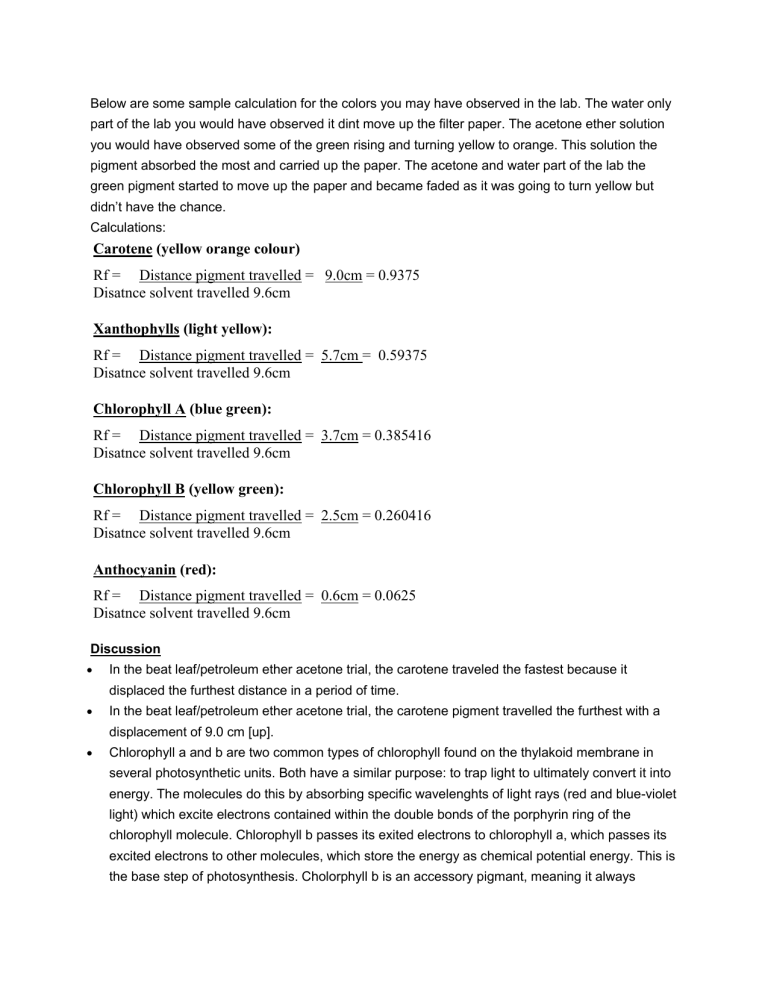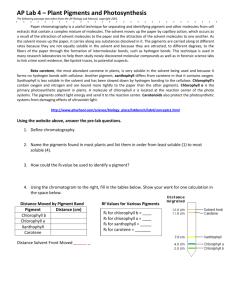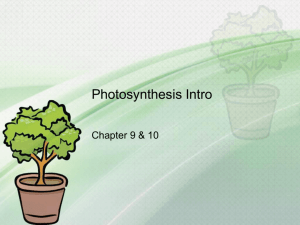Leaf Pigment Lab information

Below are some sample calculation for the colors you may have observed in the lab. The water only part of the lab you would have observed it dint move up the filter paper. The acetone ether solution you would have observed some of the green rising and turning yellow to orange. This solution the pigment absorbed the most and carried up the paper. The acetone and water part of the lab the green pigment started to move up the paper and became faded as it was going to turn yellow but didn’t have the chance.
Calculations:
Carotene (yellow orange colour)
Rf = Distance pigment travelled = 9.0cm = 0.9375
Disatnce solvent travelled 9.6cm
Xanthophylls (light yellow):
Rf = Distance pigment travelled = 5.7cm = 0.59375
Disatnce solvent travelled 9.6cm
Chlorophyll A (blue green):
Rf = Distance pigment travelled = 3.7cm = 0.385416
Disatnce solvent travelled 9.6cm
Chlorophyll B (yellow green):
Rf = Distance pigment travelled = 2.5cm = 0.260416
Disatnce solvent travelled 9.6cm
Anthocyanin (red):
Rf = Distance pigment travelled = 0.6cm = 0.0625
Disatnce solvent travelled 9.6cm
Discussion
In the beat leaf/petroleum ether acetone trial, the carotene traveled the fastest because it
displaced the furthest distance in a period of time.
In the beat leaf/petroleum ether acetone trial, the carotene pigment travelled the furthest with a displacement of 9.0 cm [up].
Chlorophyll a and b are two common types of chlorophyll found on the thylakoid membrane in several photosynthetic units. Both have a similar purpose: to trap light to ultimately convert it into energy. The molecules do this by absorbing specific wavelenghts of light rays (red and blue-violet light) which excite electrons contained within the double bonds of the porphyrin ring of the chlorophyll molecule. Chlorophyll b passes its exited electrons to chlorophyll a, which passes its excited electrons to other molecules, which store the energy as chemical potential energy. This is the base step of photosynthesis. Cholorphyll b is an accessory pigmant, meaning it always
passes its excited electrons to chlorophyll a. Chlorophyll a is the main absorber, meaning only it can pass the excited electrons to other molecules. Leaves appear green because chlorophyll is a very poor absorber of green wavelengths, therefore it reflects green light the best. Because leaves are very rich in chloroplasts containing chlorophyll for photosynthesis (photosynthesis occurs mainly on leaves), they reflect a lot of green light wavelengths, which our eyes interpret as the colour green.
As the fall comes so do the shorter days. This results in less light during the day for the plant to undergo photosynthesis. This is where the plant’s leaves begin to change colour. This allows the accessory pigments (carotene, xanthophyll) to take over the light capturing process because they are able to trap different wavelengths of light. The combined trapping ability of the accessory pigments and the regular pigments (chlorophyll A and B) allows for a greater combined absorption of light, because there are more pigments trapping a greater range of light from the visible light spectrum. This results in the plant being able to perform more photosynthesis because more photons of light are being absorbed which will result in more glucose being formed which will ultimately be stored as potential energy (in the form of sugars) during the winter months when photosynthesis doesn’t occur.
Paper chromatography is a process in which pigments are separated, from an initial concentrated solution, through the process of capillary action. A solvent is placed at the bottom of the paper.
As the solution travels up the paper, like soluble pigments will travel with the solvent until the bonds between the solvent and pigment become so weak that it must break the attraction and imprint itself a certain height up the paper.
Some factors that affect paper chromatography are:
Solvent: the solvent is a majoy factor that plays in the outcome of the experiment. A certain solvent will only attract certain pigments up the paper. For example this experiment used water soluble and lipid soluble solvents.





